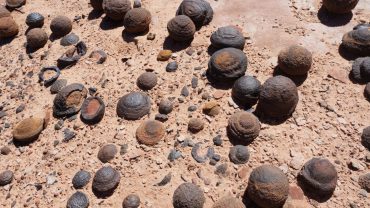The vast expanse of the Pacific Ocean has long been a theatre for maritime mysteries, but few are as perplexing as the case of the MV Joyita. In 1955, this merchant vessel vanished during a routine voyage, only to be found five weeks later adrift and deserted. The fate of her 25 passengers and crew remains one of the greatest enigmas of the sea, earning it a reputation as the Mary Celeste of the South Pacific.
So, what happened in the time between the Joyita disappearance and its discovery a few weeks later? Read on as we submerge ourselves in the Joyita mystery.
The History of MV Joyita

The MV Joyita was a luxury sailing yacht (Credit: Onne van der Wal via Getty Images)
The MV Joyita was a 69-foot wooden ship designed as a luxury yacht for Hollywood director Roland West. Launched in 1931 in Los Angeles, she was named, “Joyita,” meaning “little jewel” in Spanish. During World War II, the vessel was requisitioned by the US Navy and served as a patrol boat designated as YP-108. Her robust design and performance under duress during wartime operations attested to her durability.
After the war, the Joyita ship changed hands multiple times. In 1952, she was purchased by a university professor, who chartered her to a British-born sailor, Captain Thomas “Dusty” Miller. He lived in Samoa, operating the Joyita as a trading and charter vessel. And it was in the course of one such journey that the Joyita disappearance occurred.
The Joyita Disappearance

The Pacific Ocean, from Upolu Island in Samoa (Credit: Radoslav Cajkovic via Getty Images)
On the morning of 3rd October 1955, the MV Joyita set out from the city of Apia, on Upolu Island in Samoa, bound for the Tokelau Islands loaded with medical supplies, empty oil drums, food, and other cargo. She carried 25 people, including 16 crew members and 9 passengers, among them a government official, a doctor, two children, and various local workers. The journey of some 270 nautical miles was expected to take no more than 48 hours. Yet MV Joyita never arrived in Tokelau.
Initially, authorities suspected the delay was due to mechanical issues, especially as no distress signal had been received. The alarm was raised on 6th October, when an extensive search and rescue operation was launched, covering 100,000 square miles of ocean. But this was called off after a few days with no results. The MV Joyita had seemingly vanished.
The Mysterious Discovery: Joyita Ghost Ship Adrift

The ship was found drifting near Vanua Levu in Fiji (Credit: Douglas Peebles via Getty Images)
It was not until 10th November 1955, over five weeks later, that the Joyita ship was spotted by a merchant vessel named Tuvalu. Partially submerged and drifting over 600 miles off course near the Fijian island of Vanua Levu, she was listing heavily to port and was heavily flooded, her decks awash. Remarkably, despite all this, she was still afloat. But there was something even more unusual about the discovery: the MV Joyita was utterly deserted. There wasn’t a trace of any of the passengers or crew. And no sign of where they had gone.
Clues and Anomalies Aboard the Joyita Ship

The ship's doctor's bag was left open... (Credit: wdstock via Getty Images)
The plot of the Joyita mystery only thickened as investigators examined the scene on the ship. Their finds included the following:
Broken Radio
The ship’s auxiliary radio was tuned to the international distress frequency, indicating a possible attempt at sending a distress signal. As to why this failed, it transpired that the radio was inoperative due to faulty wiring and limited range.
Missing Items
The ship’s logbook and other navigational equipment were missing along with all of the life rafts and firearms belonging to the captain, lending credence to the theory that there had been an evacuation. Also absent however was much of the cargo; which would have been far too heavy to place on flimsy life rafts.
The Doctor’s Bag
There were no signs of a struggle, but a doctor’s bag was found open on a table, containing bloody bandages, suggesting that someone aboard had been injured and required medical attention.
The State of the Ship
Captain Miller was known to have said that MV Joyita was virtually unsinkable. This was due in part to her hull being lined with cork, boosting her buoyancy. And, indeed, she had not sunk. In fact, while she had sustained damage, the Joyita ship structure was in relatively good shape, her hull still intact. There were signs of problems however, with the bilge pumps found disassembled and the engine room flooded up to the floorboards. There were many questions to be answered. What had caused the MV Joyita to take on water? Why was she deserted? And where was everyone?
Theories and Speculation: Unravelling the Mystery

Was the ship hit by a rogue wave, or was there something more sinister afoot? (Credit: Posnov via Getty Images)
The picture that emerged was one full of contradictions. Almost immediately, theories abounded, often printed in the international press with little to no evidence. To date, none fully account for all the anomalies found, keeping the Joyita mystery unsolved.
Mechanical Failure & Abandonment
One prevalent theory is that the crew evacuated after the Joyita began taking on water. Fearing she would sink, they may have escaped using the life rafts. But those who knew Captain Miller had their doubts. He had even told colleagues he would never leave her as she was unsinkable. Some have suggested that he might not have been in a position to protest if, say, the bloodied bandages had been due to an injury he’d suffered.
Mutiny or Conflict
Another theory revolves around a possible mutiny or violent conflict among those on board the MV Joyita. Captain Miller was known to be a strict disciplinarian, and tensions may have escalated under stressful conditions. The presence of the bloodied bandages and the missing weapons could suggest a confrontation. Yet there’s no concrete evidence to support this scenario.
Piracy or External Attack
Some speculate the Joyita may have encountered pirates or hostile forces, perhaps even involvement from foreign submarines during the Cold War era. In November 1955, the Fiji Government denied newspaper reports that Japanese seamen had murdered or taken prisoner the passengers and crew. Again, there was no evidence of a struggle and no bullet holes found.
Natural Disaster
A sudden and catastrophic event such as a severe storm, rogue wave, or an encounter with a submerged object like a whale could have caused panic on the Joyita ship. But weather reports didn’t indicate such conditions, and the sturdy construction of the Joyita would have withstood typical Pacific storms.
Supernatural Explanations
Venturing into the realm of the paranormal, some have called the Joyita the Marie Celeste of the South Pacific, attributing the disappearance to unexplained phenomena or supernatural forces.
The Maritime Inquiry: Unanswered Questions Remain

Where did everybody go? (Credit: SteveDF via Getty Images)
In February 1956, a formal inquiry was convened in Apia to investigate the fate of the MV Joyita. Its conclusions seemed to resolve some questions, but left others unanswered.
Mechanical Issues
The main conclusion of the investigation was that the MV Joyita had begun taking on water due to a corroded pipe. The inquiry uncovered that the vessel was in a state of disrepair, plagued by mechanical failures and insufficient equipment. A fractured cooling pipe, along with blocked bilge pipes had allowed water to inundate the lower decks. There was evidence that the crew had attempted to fix the issue, the bilge pumps having been found blocked and disassembled. However, they’d have discovered the problem too late, leaving the crew powerless to remove the incoming water. As the Joyita began to list dangerously, the remaining engine lost the ability to maintain speed and steerage.
The Inexplicable Fate of Those Aboard
What the inquiry couldn’t explain was why the passengers and crew chose to abandon the ship. The Joyita was considered virtually unsinkable due to her cork-lined hull. This was even enhanced due to the presence of empty fuel drums onboard. As such, leaving the relative safety of the vessel for the open sea would have been a perilous decision. This was especially true given the flimsy nature of the life rafts. But with no engines and a non-functional radio, the options were limited. The inquiry concluded that, based on the evidence presented, the fate of those aboard was “inexplicable,” leaving the Joyita mystery unresolved.
Aftermath and Legacy: The Joyita Ship's Continuing Saga

Reliable communications equipment is now commonplace on all vessels (Credit: Sergii Zhmurchak via Getty Images)
The MV Joyita’s disappearance has left an indelible mark on maritime history. The incident prompted calls for changes in maritime safety regulations in the region, emphasising the need for reliable communication equipment and proper vessel maintenance, as well as powers for local authorities to prevent unsafe ships from sailing.
Remarkably, the Joyita returned to the sea in November 1956, only to run aground in January 1957 on Fiji’s Horseshoe Reef. History may then have repeated itself as passengers and crew were forced to abandon ship, adding another chapter to the Joyita’s troubled history.
The Enduring Enigma of the Joyita Ghost Ship

The ocean hides its secrets very well... (Credit: Robert Brook via Getty Images)
And thus, despite decades of investigation and speculation, the true fate of the MV Joyita’s passengers and crew remains unknown. The sea, vast and inscrutable, has kept their secrets well.












